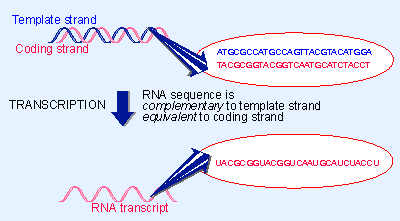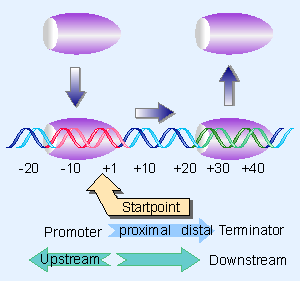1. Introduction
9.1 Introduction |
| Key terms defined in this section |
| Coding strand of DNA has the same sequence as mRNA. Downstream identifies sequences proceeding farther in the direction of expression; for example, the coding region is downstream of the initiation codon. Primary transcript is the original unmodified RNA product corresponding to a transcription unit. Promoter is a region of DNA involved in binding of RNA polymerase to initiate transcription. RNA polymerases are enzymes that synthesize RNA using a DNA template (formally described as DNA-dependent RNA polymerases). Terminator is a sequence of DNA, represented at the end of the transcript, that causes RNA polymerase to terminate transcription. Transcription unit is the distance between sites of initiation and termination by RNA polymerase; may include more than one gene. Upstream identifies sequences proceeding in the opposite direction from expression; for example, the bacterial promoter is upstream from the transcription unit, the initiation codon is upstream of the coding region. |
 |
Figure 9.1 The function of RNA polymerase is to copy one strand of duplex DNA into RNA. |
Transcription involves synthesis of an RNA chain representing one strand of a DNA duplex. By "representing" we mean that the RNA is identical in sequence with one strand of the DNA, which is called the coding strand. It is complementary to the other strand, which provides the template for its synthesis. This relationship between double-stranded DNA and its single-stranded RNA transcript is recapitulated in Figure 9.1.
 |
Figure 9.2 A transcription unit is a sequence of DNA transcribed into a single RNA, starting at the promoter and ending at the terminator. |
RNA synthesis is catalyzed by the enzyme RNA polymerase. Transcription starts when RNA polymerase binds to a special region, the promoter, at the start of the gene. The promoter surrounds the first base pair that is transcribed into RNA, the startpoint. From this point, RNA polymerase moves along the template, synthesizing RNA, until it reaches a terminator sequence. This action defines a transcription unit that extends from the promoter to the terminator. The critical feature of the transcription unit, depicted in Figure 9.2, is that it constitutes a stretch of DNA expressed via the production of a single RNA molecule. A transcription unit may include more than one gene.
Sequences prior to the startpoint are described as upstream of it; those after the startpoint (within the transcribed sequence) are downstream of it. Sequences are conventionally written so that transcription proceeds from left (upstream) to right (downstream). This corresponds to writing the mRNA in the usual 5′ 3′ direction.
Often the DNA sequence is written just to show the coding strand, whose sequence is the same as the RNA. Base positions are numbered in both directions away from the startpoint, which is assigned the value +1; numbers are increased going downstream. The base before the startpoint is numbered V1, and the negative numbers increase going upstream.
The immediate product of transcription is called the primary transcript. It would consist of an RNA extending from the promoter to the terminator, possessing its original 5′ and 3′ ends. However, the primary transcript is almost always unstable. In prokaryotes, it is rapidly degraded (mRNA) or cleaved to give mature products (rRNA and tRNA). In eukaryotes, it is modified at the ends (mRNA) and/or cleaved to give mature products (all RNA).
Transcription is the first stage in gene expression, and the principal step at which it is controlled. Regulatory proteins determine whether a particular gene is available to be transcribed by RNA polymerase. The initial (and sometimes the only) step in regulation is the decision on whether or not to transcribe a gene. In considering the various stages of transcription, we should therefore keep in mind the opportunities they offer for regulating gene activity.
Within this context, there are two basic questions in gene expression:
- How does RNA polymerase find promoters on DNA? This is a particular example of a more general question: how do proteins distinguish their specific binding sites in DNA from other sequences?
- How do regulatory proteins interact with RNA polymerase (and with one another) to activate or to repress specific steps in the initiation, elongation, or termination of transcription?
In this chapter, we analyze the interactions of bacterial RNA polymerase with DNA, from its initial contact with a gene, through the act of transcription, culminating in its release when the transcript has been completed. 10 The operon discusses the various means by which regulatory proteins can assist or prevent bacterial RNA polymerase from recognizing a particular gene for transcription. In 11 Phage strategies we consider how individual regulatory interactions can be connected into more complex networks. In 20 Initiation of transcription and 21 Regulation of transcription, we consider the analogous reactions between eukaryotic RNA polymerases and their templates.